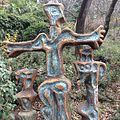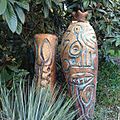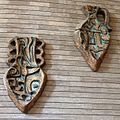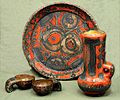Vladimir Sakhnenko
This article contains translated text and the factual accuracy of the translation should be checked by someone fluent in Russian and English. |
Vladimir Sakhnenko | |
|---|---|
 | |
| Born | 10 January 1930 |
| Died | 31 July 2008 (aged 78) |
| Known for | Ceramics, painting, drawing |
Vladimir Sakhnenko (Russian: Влади́мир Сахне́нко; born 10 January 1930, in the Sumy region of Ukraine[1][2][3] – 31 July 2008, Tula) was a painter and ceramist, and a member of the Union of Artists of the USSR since 1967.[3] He is the father of artist Ivan Sakhnenko.[4]
Sakhnenko finished the art school in Voroshilovograd in 1951 and then studied at the Surikov Academic Institute in Moscow,[3] where he met Ilya Kabakov[5] and his future wife – sculptor Zoya Riabchenko.[4] He took part in art exhibitions since 1957.[3] He lived and worked in Tula.
Ceramics
[edit]Vladimir Sakhnenko created monumental objects, exterior ceramics and pottery houseware. The utility and decorativeness of his works served to conceal experiments with design and form, seditious for the Soviet period, which he continued in painting.[4]
Many of his works still adorn cultural centres, Tula Drama Theatre, Intourist hotel in Yalta and the government dacha in Foros. State Museum of Culture History of Uzbekistan in Samarkand and World Trade Centre in Moscow are also the holders of Vladimir Sakhnenko's ceramics.[1][4]
He worked daily in his workroom at Kislotoupor Shchyokino factory making crocks, vases, amphorae, flowerpots, multiple ceramic constructions, and ceramic sculptures of various creatures, almost until the end of his life.
He used chamotte, mostly with glaze. In the late 1970s he discovered a temperature-resistant composition of blue-green glaze that could survive extreme weather conditions, including frost. Sakhnenko's glazed ceramics have been held out of doors in Samarkand and Crimea for almost 40 years.[4]
Painting
[edit]In the 1970s the artist created 13 large black and white canvases (held in Erarta Museum[1]). In the early 1980s, Vladimir Sakhnenko turned to making bright paintings: portraits, still lives and works that depict biblical scenes.[1] His personal style (both in painting and pottery) features easy switch from figurativeness to abstraction and ornamentality.
Art collections
[edit]- Erarta Museum of Contemporary Art, Saint Petersburg
- Art Season Gallery and Art Caravan Gallery, Moscow
- State Museum of Culture History of Uzbekistan, Samarkand
- Tula Museum of Fine Arts
Recent exhibitions
[edit]- 1999 — On the Staraya Basmannaya Street Gallery, Moscow, featuring his son Ivan Sakhnenko
- 2005 — Autumn Marathon, Central House of Artists, Moscow, featuring Ivan Sakhnenko, Avetik and others
- 2006 — Revelation of Colour, Central House of Artists, Moscow, solo exhibition, Art Caravan Gallery
- 2007 — Abstract Art. The Early 21st Century, Central House of Artists, Moscow
Selected works
[edit]Ceramics
[edit]-
Big vase on the roof of Yalta Hotel Complex
-
Figures in the garden of Yalta Hotel Complex
-
Two amphoras in the garden of Yalta Hotel Complex
-
Two amphoras on the roof of Yalta Hotel Complex
-
Two stoneware figures in the garden of Yalta Hotel Complex
-
Two amphoras in the swimming pool of Yalta Hotel Complex
-
Two wall amphoras in the swimming pool of Yalta Hotel Complex
-
Vessel, glazed chamotte
-
Table set, 1979
Paintings
[edit]-
Adam and Eve, 1979, oil canvas, 75x58
-
Roses, 1979, oil canvas, 57x68
-
About love, 1980, oil canvas, 100x95
-
Confession, 1980, oil canvas, 100x93
-
Composition, 1980, oil canvas, 105x65
-
The Seven Leaf Plant, 1980, oil canvas, 72x63
-
Madonna and Child, 1981, oil canvas, 100x53
-
Magi, 1981, oil canvas, 128х102
-
Sergey, 1982, oil canvas, 113x63
-
Still Life with Lemon, 1982, oil canvas, 85x90
-
Lord's Supper, 1982, oil canvas, 85x320
References
[edit]- ^ a b c d Vladimir Sakhnenko, Erarta Museum of Contemporary Art, Saint Petersburg
- ^ Erarta galleries St. Petersburg about ceramics by Vladimir Sakhnenko
- ^ a b c d АРТ-Казна: Каталог выставки (PDF) (in Russian). Tula, Russia. 2013. p. 152. Retrieved 2 February 2016.
{{cite book}}: CS1 maint: location missing publisher (link) - ^ a b c d e Кончин, Евграф (2009). Холст как мера вечности: Статьи, интервью, рецензии (in Russian). Moscow: Живопись-Инфо. pp. 266–269. Retrieved 2 February 2016.
- ^ Илья Кабаков нашел в музее Эрарта работы своего друга со студенческих времен… (in Russian). Erarta. 28 June 2010. Retrieved 2 February 2016.



















